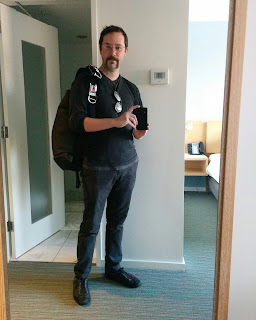 |
| Fred Scharmen, City Paper 2015 |
So much of our identity and loyalty is tied to our tiny neighborhoods, and our tight travel patterns between them, we hardly even leave our own familiar blocks, much less the city itself....As we all do more exploring within our city, let’s not let our preconceived notions about crime, race, and class prevent us from seeing what’s actually going on in a place. (Fred Scharmen, City Paper January 6,2015)He is an astute observer of Baltimore who doesn't shy away from comment and intervention as an activist in the community. As I reported in yesterday's article, Scharmen recently wrote a letter Baltimore City Council members to urge them to withhold money from the budget that is dedicated for the demolition of the McKeldin Fountain.
Here the interview:
 |
| Fred Scharmen |
At what age did you decide to become an architect?
Very early. My dad has been a carpenter and contractor all of his life, so I was on jobsites and looking through old industry magazines like Progressive Architecture all of the time. There were two things I realized before high school: that I liked to draw more than I liked to do construction work, and that buildings didn’t have to all look alike!
What was the main reason you picked architecture as your
profession?
I knew I wanted to keep studying art, drawing, and space, architecture seemed to be the best way to do this. I’m lucky that I’ve been able to keep working with artists in my practice now.
What do you consider as your (or your firm’s) best project?
Give one reason why? (Please attach one photo of the project)
 |
| Scharmen project: Green outdoor living room |
We made an outdoor green living room on top of a rebuilt garage in Fells Point. The client is an illustrator who works from home, and she’s able to walk right out of her studio into this space. The material and tectonics contribute to a lightweight, airy spatial quality, and every surface acts like a filter, mediating light, views, and rainwater.
What is your favorite work of architecture worldwide? Give
one reason why.
The Halley VI Research Station by Hugh Broughton Architects and AECOM, on the Brunt Ice Shelf in Antarctica, it’s a modular structure on legs that can be reconfigured and moved as snow builds up and the ice shifts. Nothing is stable in this environment, and the project adapts some old futuristic ideas from the 1960s to respond to this.
Scharmen favorite: Halley VI station, Antarctica
How would you describe the state of built architecture in
Baltimore based on what has been built in the last 30 years.
There’s a sense that anything is better than nothing, and corresponding devaluation of critique and dialogue about what should be built and why.
I am fascinated by Harlem Park, it is a neighborhood with very serious problems, and very interesting structure and texture.
What single piece of advice would you give the new Mayor
regarding Baltimore’s built environment?
I’m pleased that the Democratic nominee is someone who has an interest in design, both as an educational tool, and as a means of adding value to the city. I hope that any new Mayor we have can keep those principles at the forefront of their thinking about the city.
What do you see as Baltimore’s biggest problem. Name one
idea how to overcome it.
Baltimore has a lot to answer for with regard to its legacy of using the built environment to segregate and discriminate against its black residents. This city was an innovator in using the real estate industry and urban design to create and maintain inequality. The city needs to focus on and incentivize investment in areas outside the “White L” centered on Charles St. and along the water. Transportation would be a good start, there are few easy ways to go east/west in this city. How about a cross-town circulator, if we’re not going to get the Red Line?
What would you like to be remembered for?
Hopefully, as someone who was at least an okay educator! I’ve been lucky to have the opportunity to engage with teaching at Morgan State’s School of Architecture and Planning, and along with service and research, that’s become a cornerstone of practice for me.
One final comment of your own choice.
To anyone out there reading this – get in touch if you’d like to be on one of the juries for my first-year design studios!
Updated to correct employment status at Morgan to tenure track professor.


Hundreds of millions, perhaps billions, in today's dollars, have been "invested" outside the "White L" -- including in Harlem Park (where hundreds of alley houses were removed to create inner-block parks in an early urban renewal effort), Sandtown, Pigtown Pennsylvania Avenue, Oldtown, and Lower Park Heights. Nearly the entire Metro Subway is outside this area, as is half the Light Rail and the majority of "quick buses." Pennsylvania Avenue alone has two subway stops, one of which was the ground zero for the Freddie Gray riots. Here's reality: there are 40,000 fewer blacks in this city today than 25 years ago, and that number is growing as families head to the 'burbs and to cities in the South where there's more opportunity.
ReplyDelete